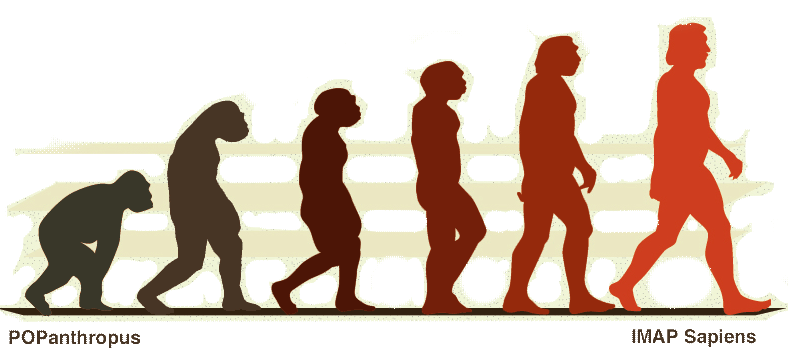IMAP vs POP3 - How to Email in the 21st Century


Make sure to back up your email before switching to IMAP.

Both POP (Post Office Protocol) and IMAP (Internet Message access protocol) allow people to get access to their email from a remote server; however, that is where most similarities end. POP simply downloads email to your computer, and usually (but not always) deletes the email from the remote server. The problems arise if you have more than one device where you read your mail (desktop, laptop, tablet or phone). Here's why it's bad: You have to delete or file the same email on every device
Logging into each device, you will see lots of unread emails with no indication of which you deleted, read, flagged or filed Any folders you created and organize on one device won't be replicated on the other devices
IMAP allows users to store their email on remote servers. This two-way protocol also allows the user to synchronize their email among multiple devices, which is extremely important today, when most people have at least two devices - their laptop and smartphone.
The original POP was developed in 1984 to offer people with a simple means of accessing their email on a remote server. This first protocol required the use of a user name and password and downloaded all the email at once. The release of POP2 in 1985 provided a greater range of commands and replies. Additionally, POP2 allowed the user to choose to read only one message instead of having to download all their email at the same time. In 1988, the release of POP3 made accommodations for the users of personal computers to retrieve their email simply, efficiently, and easily. No revisions have been made to POP since 1998 (that's 14 years ago, an eternity in Internet years).
People who access their email account from computer, and back-up their hard drive regularly, can get by with using POP. Although it is possible to arrange to have email stored on the remote servers of most ISPs and other email service providers, downloading email is a slow process if the user has a large number of messages stored on the remote server.
Mark Crispin developed the first IMAP at Stanford University in 1986 as an alternative to POP. IMAP has the advantage of being a two-way protocol that provides greater functionality for the user. A revision to IMAP was released shortly afterwards that allowed for tagging commands and responses. The next revision, released in the early 1990s and known as IMAP2bis, provided for the use of Multipurpose Internet Mail Extensions (MIME), which allowed for an increase in the number of functions used in the management of mailboxes. The 1996 release of IMAP4rev1 allowed for both encrypted and plain text passwords for logins. Another improvement made in the release of IMAP4 rev1 was the encryption of emails.
For people using multiple computers and devices, such as mobile phones and tablets, the ability to synchronize email actions among devices is essential. When a person uses IMAP, and he or she reads, deletes or moves email into folders, the action occurs across all devices simultaneously. Since it is possible to download only the email headers with IMAP, it's much quicker. Additionally, any offline changes that are made to email are transmitted to the remote server once an Internet connection is re-established. Essentially, IMAP allows the user to archive their email on their computer or device while having a backup stored on the remote server. Additionally, business users, especially those in professions that demand confidentiality, prefer to use IMAP since it allows for the added security email encryption affords.
POP should have been dead a long time ago, but a lot of people still use it because they don't know how to switch to IMAP. It's actually quite easy and usually takes less than 10 minutes, but you have to know how. We made this site just for you. On the next page, you'll see a table showing instructions specific to A) the email service and B) the client you use. Follow these steps and you'll be all set in a few minutes!
Make sure to back up your hard drive before switching to IMAP, in case something goes wrong.